The Ratio of Readers to Donors is Staggering
The problem is simple, for every “2000” readers who come to Reader Supported News “1” donates.
Give us a hand here folks.
Marc Ash
Founder, Reader Supported News
If you would prefer to send a check:
Reader Supported News
PO Box 2043 / Citrus Heights, CA 95611
Follow us on facebook and twitter!
Live on the homepage now!
Reader Supported News
”I wanted due process, but I had 36 colleagues and a majority leader who wouldn’t give it to me,“ former senator says
“I’m keeping my options open,” he told the paper. “Right now my focus is on doing this (tour) and doing other stuff that is more politically blatant.”
The “Saturday Night Live” alum resigned under pressure from the U.S. Senate in December 2017 after multiple women accused him of inappropriate touches or kisses. Franken has since said that he regrets the decision to step down, pinning the blame on Senate Majority Leader Chuck Schumer.
“I wanted due process, but I had 36 colleagues and a majority leader who wouldn’t give it to me, so it was impossible. But you do have some regrets,” he told The Republican. “It was a very weird, tough situation at that moment … I love the Senate. I love the work that I did.”
Franken previously spoke out about his resignation in a 2019 New Yorker profile in which seven other current and former senators said they regretted calling for him to step down.
Franken has since returned to comedy, including an upcoming stand-up tour that will attempt to “make a difference satirically,” he said. “Because I believe comedy and satire is a very valid way — and sometimes almost a more productive way — of affecting public opinion.”
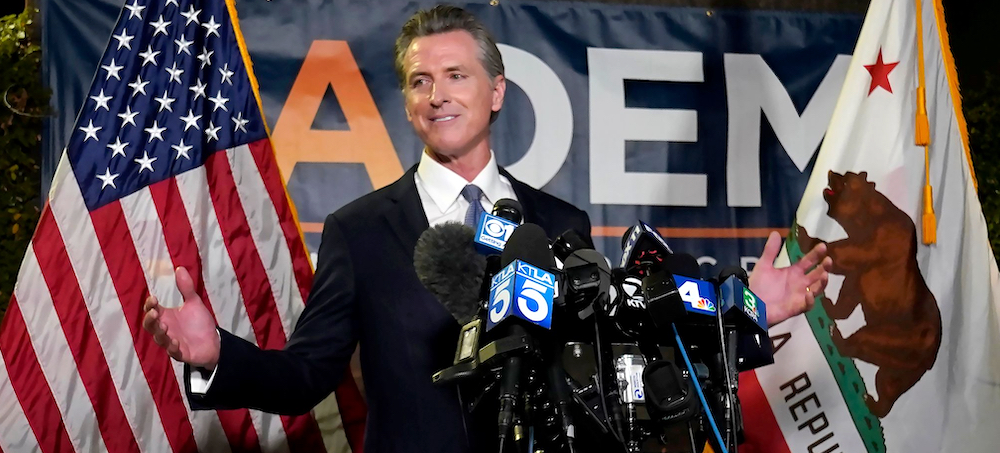 California governor Gavin Newsom holds a news conference after winning his recall vote. (photo: AP)
California governor Gavin Newsom holds a news conference after winning his recall vote. (photo: AP)
Newsom bolted to a quick victory boosted by healthy turnout in the overwhelmingly Democratic state. He cast it as a win for his handling of the pandemic and liberal issues, and it ensures the nation’s most populous state will remain in Democratic control as a laboratory for progressive policies.
“‘No’ is not the only thing that was expressed tonight,” Newsom said. “I want to focus on what we said ‘yes’ to as a state: We said yes to science, we said yes to vaccines, we said yes to ending this pandemic.”
With an estimated two-thirds of ballots counted, “no” on the question of whether to recall Newsom was ahead by a 30-point margin. That lead was built on votes cast by mail and in advance of Tuesday’s in-person balloting, with a strong showing by Democrats. While likely to shrink somewhat in the days ahead as votes cast at polling places are counted, Newsom’s lead couldn’t be overcome.
Republican talk radio host Larry Elder almost certainly would have replaced Newsom had the recall succeeded, an outcome that would have brought a polar opposite political worldview to Sacramento.
The recall turned on Newsom’s approach to the pandemic, including mask and vaccine mandates, and Democrats cheered the outcome as evidence voters approve of their approach. The race also was a test of whether opposition to former President Donald Trump and his right-wing politics remains a motivating force for Democrats and independents, as the party looks ahead to midterm elections next year.
Republicans had hoped for proof that frustrations over months of pandemic precautions would drive voters away from Democrats. The GOP won back four U.S. House seats last year, success that Republican leaders had hoped indicated revived signs of life in a state controlled by Democrats for more than a decade.
But a recall election is an imperfect barometer — particularly of national trends. Democrats outnumber Republicans nearly 2-to-1 in California, so the results may not translate to governors in toss-up states or reflect how voters will judge members of Congress next year.
Trump, who had largely stayed out of the contest, made unsubstantiated claims that the election was rigged in the closing days, claims echoed by Elder’s campaign. Elder did not mention fraud as he addressed his supporters after the results were in.
“Let’s be gracious in defeat. We may have lost the battle, but we are going to win the war,” he said, later adding that the recall has forced Democrats to focus on issues such as homelessness and California’s high cost of living.
Newsom for months had likened the recall to efforts by Trump and his supporters to overturn the presidential election and a push in Republican-led states to restrict voting access.
“Democracy is not a football, you don’t throw it around. It’s more like — I don’t know — an antique vase,” Newsom said after his win. “You can drop it, smash it into a million different pieces — and that’s what we’re capable of doing if we don’t stand up to meet the moment and push back.”
He became the second governor in U.S. history to defeat a recall, cementing him as a prominent figure in national Democratic politics and preserving his prospects for a future run. Republican Wisconsin Gov. Scott Walker survived a recall in 2012.
California voters were asked two questions: Should Newsom be recalled, and, if so, who should replace him? Only a handful of the 46 names on the replacement ballot had public recognition, but most failed to gain traction with voters.
Elder entered the race just two months ago and quickly rose to the top of the pack. But that allowed Newsom to turn the campaign into a choice between the two men, rather than a referendum on his performance.
Newsom seized on Elder’s opposition to the minimum wage and abortion rights as evidence he was outside the mainstream in California. The governor branded him “more extreme than Trump,” while President Joe Biden, who campaigned for Newsom, called him “the closest thing to a Trump clone I’ve ever seen.”
Though the contest didn’t quite bring the circus-like element of California’s 2003 recall — when voters replaced Democratic Gov. Gray Davis with Republican movie star Arnold Schwarzenegger — it featured quirky moments of its own.
Reality TV star and former Olympian Caitlyn Jenner entered the race but gained little momentum and left the state for part of the campaign to film a reality show in Australia. Businessman John Cox, who lost badly to Newsom in 2018, tried to spice up his campaign by hiring a live bear to join him, branding himself as the “beast” to Newsom’s “beauty.”
Newsom will soon be campaigning again; he’s up for reelection next year.
Orrin Heatlie, the Republican who launched the recall effort last year, cast it as a “David and Goliath” battle and said it was telling that Newsom had called on national Democrats like Biden to “salvage his damaged political career.”
The president and other prominent Democrats offered Newsom support in the race’s closing days, while national Republican leaders largely kept the contest at arm’s length.
The recall needed 1.5 million signatures to make the ballot out of California’s 22 million registered voters. It never would have come before voters if a judge hadn’t given organizers four extra months to gather signatures due to the pandemic. That decision came the same day Newsom attended a maskless dinner at the lavish French Laundry restaurant with lobbyists and friends, stirring outcry.
Supporters of the recall expressed frustration over monthslong business closures and restrictions that kept most children out of classrooms. Rising homicides, a homelessness crisis and an unemployment fraud scandal further angered Newsom’s critics.
But the broader public stayed on his side. Polling from the Public Policy Institute of California showed his approval rating remaining above 50% throughout the pandemic. With weeks to go, the institute’s poll showed 60% of Californians approved of Newsom’s handling of the pandemic.
The rise of the highly contagious delta variant led Newsom to frame the race as one of “life or death” consequences. He pointed to Texas and Florida, which were seeing worsening surges as their Republican governors rejected mask and vaccine mandates, as cautionary tales for what California could become.
Newsom has been viewed as a potential White House contender since at least 2004, when he defied federal law to issue marriage licenses to LGBT couples as mayor of San Francisco. His victory maintained those prospects, though he will still have to navigate around the ambitions of Harris, who came up through San Francisco politics alongside Newsom.
He came to the contest with advantages. California’s electorate is less Republican, less white and younger than it was in 2003, when voters booted the Democratic Davis. Newsom was allowed to raise unlimited funds, dwarfing his competitors while flooding TV screens with advertising. Public worker unions and business and tech executives poured millions into his campaign.
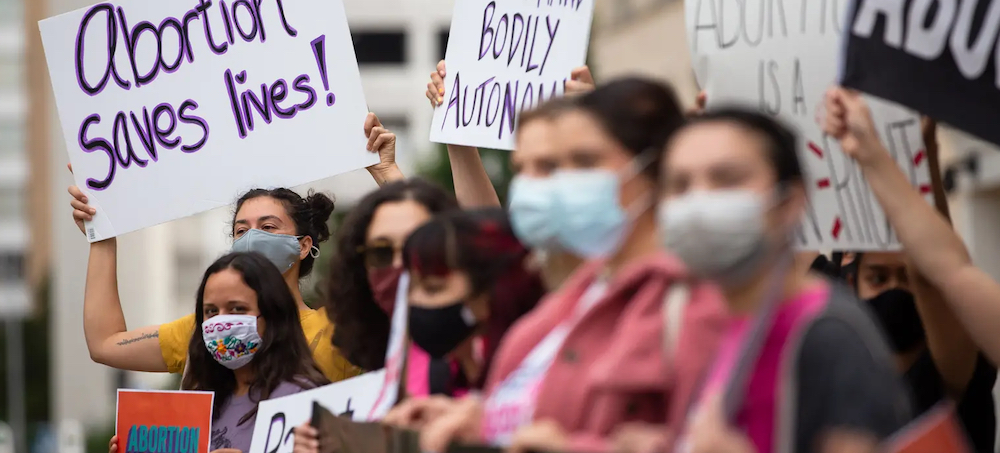 Demonstrators protest anti-abortion laws in front of the Governor's Mansion in Austin, Texas. (photo: Evan L'Roy/The Texas Tribune)
Demonstrators protest anti-abortion laws in front of the Governor's Mansion in Austin, Texas. (photo: Evan L'Roy/The Texas Tribune)
This step, a major move by the Biden administration against the highly controversial law, follows a lawsuit filed by the Justice Department last week. The Biden administration asked the court late Tuesday to implement the preliminary injunction while the lawsuit plays out in federal court.
Texas's abortion ban essentially stops the procedure in the country's second-largest state. Most people don't know they are pregnant before six weeks.
In court documents, attorneys for the Justice Department said Texas' law, also called S.B. 8, is unconstitutional and cannot stand.
A preliminary injunction "is necessary to protect the constitutional rights of women in Texas and the sovereign interest of the United States in ensuring that its States respect the terms of the national compact," the attorneys say. "It is also necessary to protect federal agencies, employees, and contractors whose lawful actions S.B. 8 purports to prohibit."
The Justice Department stepped in to challenge the Texas law after the U.S. Supreme Court refused to block the policy. The justices' 5-4 vote did keep the door open for future challenges, like this new case by the federal government, to be revisited by the justices down the road.
Shortly after it went into effect, President Biden called the Texas law "extreme" and said it "blatantly violates the constitutional right established under Roe v. Wade and upheld as precedent for nearly half a century."
Texas' law is considered the most strict in the nation, in part because it allows private citizens to sue anyone perceived to be helping patients obtain abortions. It doesn't make exceptions for cases involving rape or incest.
It was also drafted to make legal challenges by abortion-rights supporters extremely difficult.
Attorneys for the Justice Department told the federal judge through its filing on Tuesday that the law "was designed to create jurisdictional obstacles to the ability of women and providers to sue to protect their rights."
Despite those obstacles, the Justice Department believes the federal government "has the authority and responsibility to ensure that Texas cannot insulate itself from judicial review for its constitutional violations and to protect the important federal interests that S.B. 8 impairs."
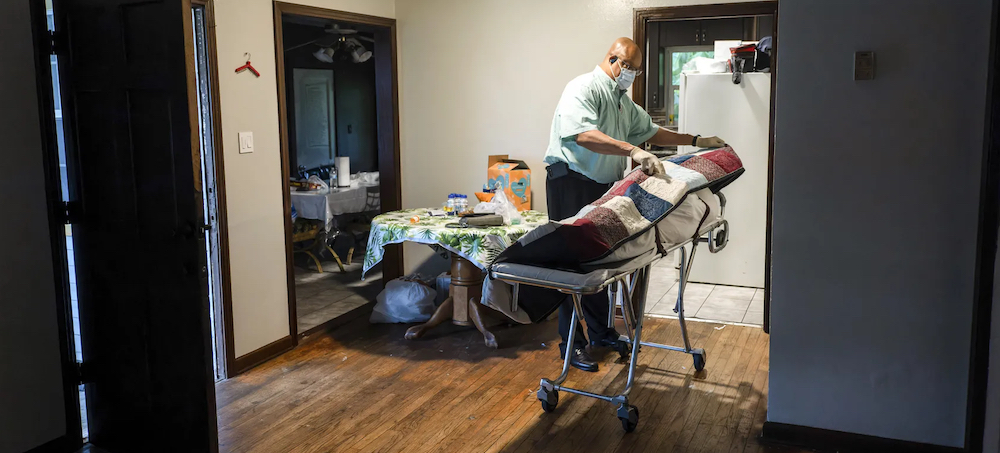 A funeral home worker covers the body of a woman, 54, who died at home of Covid-19 in Houston on September 13. (photo: John Moore/Getty Images)
A funeral home worker covers the body of a woman, 54, who died at home of Covid-19 in Houston on September 13. (photo: John Moore/Getty Images)
The country’s pandemic failures have sometimes led to deadly health care rationing.
In other words, US hospitals are being forced — in the middle of a public health emergency — to ration health care for their patients.
Rationing has long been a dirty word in US health policy, used as an attack on any socialized health program that more centrally determines which medical services will be covered and for whom. The US health system has always rationed care through cost: It’s de facto rationing when a patient doesn’t get the medical care they need because they can’t pay out-of-pocket costs or because they live in a rural community without a facility nearby.
“We’re so used to rationing by ability-to-pay in this country that classic capacity rationing feels a bit foreign,” Hannah Neprash, a health economist at the University of Minnesota, said in an email.
The delta variant, more contagious and virulent than its predecessors, and America’s lagging vaccination rates are driving the current crisis.
The states with the worst outbreaks in confirmed cases per capita right now — Tennessee, Kentucky, Alaska, Wyoming, and West Virginia, according to the New York Times’s tracker — have either set new hospitalization records in the last several weeks or are near their previous highs from the winter wave. All of them have vaccination rates below the national average. Throughout the South, hospitals are reporting they have more patients in need of ICU care than ICU beds available, as the Times reported on Tuesday.
America, the richest country in the world, is not supposed to be a place where patients are left at the door to die. Yet that is exactly what’s happening now — 18 months into the pandemic.
The US health system wasn’t built to withstand a pandemic
Many parts of the American health system have struggled to handle the pandemic. The current hospitalization crisis is just the latest iteration of an institutional failure.
The United States still has a lot of unvaccinated people who are fully vulnerable to the delta variant of the novel coronavirus, which is more transmissible and may cause more virulent disease. One in four people over 18 still haven’t received any dose of a Covid-19 vaccine, and younger age cohorts have lower vaccination rates than their elders. As a result, there has been a shift in who’s being hospitalized: People over 65 made up more than half of hospitalizations in December and January; now they are about a third. Children under 12 still are not eligible for the vaccines, and pediatric hospitals are seeing their highest number of Covid-19 patients ever.
But while the demographics of the people being hospitalized may have shifted, the sheer number of people getting severely ill with Covid-19 and ending up in the hospital is almost as high as it has ever been.
Texas, to give one example, has nearly matched its winter peak with more than 14,200 people currently hospitalized with Covid-19. More than 90 percent of the state’s ICU beds are occupied, according to Covid Act Now. In Idaho, with about 88 percent of ICU beds in use, hospitals had to activate what is known as “crisis” standards of care. That gives them more discretion to prioritize the patients most likely to survive for ICU beds and other treatment.
In Bellville, Texas, 46-year-old military veteran Daniel Wilkinson was rushed to the emergency room. He was diagnosed with gallstone pancreatitis, which is treatable but which his local hospital was not equipped to treat, according to KPRC. The doctor called all over the region — to hospitals in Texas, Oklahoma, and Arkansas, among others — but could not find a hospital that would take him. Those states currently have some of the highest Covid-19 hospitalization rates in the country.
An ICU bed was eventually located at a Houston Veterans Administration hospital, more than an hour away from Bellville. But Wilkinson’s organs started failing on the helicopter ride there and he died. It had been more than seven hours since his mother first brought him to the local ER.
There are more stories like Wilkinson’s across the United States. On Monday, the Washington Post reported that a 73-year-old Alabama man died of a cardiac emergency after being turned away from more than 40 hospitals. The closest hospital that would take him was 200 miles away in Mississippi. Alabama is currently experiencing the second-most Covid-19 hospitalizations per capita in the nation.
Hospitals are trying to balance handling a new Covid-19 surge with providing medical care to all of the other patients who need their attention. But that has required them to make some hard choices.
Karen Joynt Maddox, a practicing physician and health policy researcher at Washington University in St. Louis, said her local hospital was instructed during the pandemic not to take patients from small rural facilities unless absolutely medically necessary, which at times has meant rejecting transfer requests made by family members.
The US does not have a lot of hospital beds compared to many other wealthy countries; about 2.9 per 1,000 people compared to the average of 4.6, according to the Peterson-Kaiser Health System Tracker.
There are some good reasons for that: Over the decades, more medical services have been shifted from inpatient to outpatient settings in order to save costs. But that still ended up shrinking the number of hospital beds available in a once-in-a-lifetime emergency.
We wouldn’t necessarily want the US health system to always be flush with excess hospital capacity, some experts contend. It would cost substantial funding to maintain. But even in normal times, urban hospitals will operate at near 100 percent capacity while rural hospitals sit with half their beds open.
“We have beds, just not in the right places,” Joynt Maddox said, “and with no system to try to use the available beds as rationally as possible.”
The current crisis has revealed how disorganized the US health system truly is. American hospitals don’t have a reliable revenue stream, as hospitals do in countries with budgets that pay providers a predictable amount of money every year.
And there is no central authority to help manage the patient load when US hospitals are overwhelmed; Daniel Wilkinson’s doctor made those calls on his own. As NPR reported, local hospital leaders across the country have been left making desperate pleas to other facilities hundreds of miles away.
Other wealthy nations were better equipped to handle their Covid-19 surges
That disorganization is what distinguishes the US from other wealthy countries with different health systems — and arguably contributed to some of these terrible outcomes.
America is not alone in being tested by the coronavirus. Other wealthy nations saw their hospitals strained in the pandemic, especially early on, when countries like Italy endured some of the worst initial coronavirus outbreaks.
But a year and a half into the pandemic, those other countries appear better equipped to handle the load, aided by both higher vaccination rates and more cohesive health systems.
The US is mediocre in terms of hospital capacity, but it’s not at the bottom among its economic peers. Both Canada and the United Kingdom, with government-run health programs for every citizen, actually have slightly fewer hospital beds per capita.
And they neared their limits during the worst waves of the pandemic. The UK’s National Health Service was forced to transfer ICU patients to less congested areas during the fall and winter surges. In Ontario, more than 2,500 patients have been moved to other cities in order to receive lifesaving care. Even in France, which has significantly more hospital beds per capita than the US, more than 100 Covid-19 patients had to be evacuated as Paris hospitals ran low on beds.
These are not quite the same horror stories as we are seeing in the US, however, because there was a stronger level of coordination among the hospitals. In all of these international cases, either the national or local government managed the movement of patients.
No such system exists in the US; it is largely done informally. I spoke with a California hospital executive last summer who had to call a nearby hospital himself, looking for a ventilator when his facility was running low on those lifesaving machines.
Other countries appear to have avoided unnecessary deaths because they have a real system to coordinate care. In Britain, hospitals are currently able to handle more emergency care than the average volume prior to the pandemic, according to recent research by the Nuffield Trust, though elective surgeries are still sometimes being canceled.
“Hospitals have been incredibly stretched but have always been able to offer urgent and emergency care,” Nick Scriven, a UK doctor and past president of the Society of Acute Medicine, told me. “People were not turned away if they needed a hospital bed.”
The pandemic laid bare how disastrously disorganized the US health system is. But that’s always been true. It just usually reveals itself in more subtle ways.
An overwhelmed ER in a downtown urban setting might lead to some patients leaving without being seen. Low staffing at certain times — US hospitals stand out from their international peers because they have more administrative staff and less medical staff — appears to lead to worse outcomes. And then you have the higher out-of-pocket costs borne by Americans, which have been shown to lead to people skipping or postponing necessary medical care.
As Ezra Klein wrote for Vox last year, in covering the UK’s National Health Service, every health system rations care. There are not unlimited resources. But while in the US that rationing occurs in subtle and haphazard ways, other countries have tried to build a more rational system for managing their medical capacity.
That left them better positioned to handle surges of sick patients during the pandemic. America is paying the price for its failure to do the same thing.
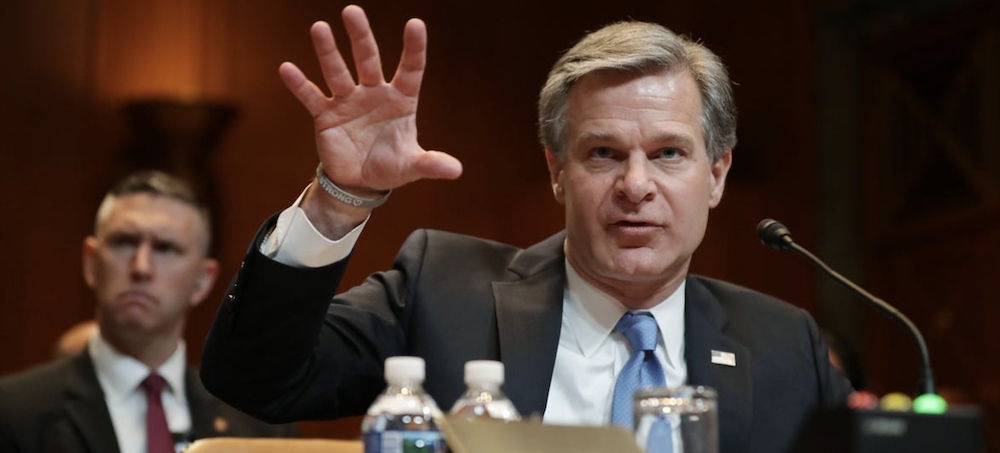 Federal Bureau of Investigation Director Christopher Wray. (photo: Getty Images)
Federal Bureau of Investigation Director Christopher Wray. (photo: Getty Images)
Claim that FBI lacked authority to conduct further investigation into Kavanaugh may be inaccurate
At the heart of the new questions that Wray will face later this week, when he testifies before the Senate judiciary committee, is a 2010 Memorandum of Understanding that the FBI has recently said constrained the agency’s ability to conduct any further investigations of allegations of misconduct.
It is not clear whether that claim is accurate, based on a close reading of the MOU, which was released in court records following a Freedom of Information Act request.
The FBI was called to investigate allegations of sexual misconduct against Kavanaugh during his Senate confirmation process in 2018, after he was accused of assault by Christine Blasey Ford, a professor who knew Kavanaugh when they were both in high school. He also faced other accusations, including that he had exposed himself to a classmate at Yale called Deborah Ramirez. Kavanaugh denied both accusations.
The FBI closed its extended background check of Kavanaugh after four days and did not interview either Blasey Ford or Kavanaugh. The FBI also disclosed to the Senate this June – two years after questions were initially asked – that it had received 4,500 tips from the public during the background check and that it had shared all “relevant tips” with the White House counsel at that time. It is not clear whether those tips were ever investigated.
The FBI said in its letter to two senators – Sheldon Whitehouse and Christopher Coons – that the FBI did not have the authority under the 2010 MOU at the time to “unilaterally conduct further investigative activity absent instructions from the requesting entity”. In other words, the FBI has said it would have required explicit instructions from the Trump White House to conduct further investigation under the existing 2010 guidelines on how such investigations ought to be conducted.
But an examination by the Guardian of the 2010 MOU, which was signed by the then attorney general, Eric Holder, and then White House counsel, Robert Bauer, does not make explicitly clear that the FBI was restricted in terms of how it would conduct its investigation.
The MOU, which was released in court documents in 2019 as part of Freedom of Information Act litigation brought against the US government by Buzzfeed, also does not explicitly state that the White House had the power to set the process parameters on any investigation. The MOU does seem to suggest that the White House had the authority to limit the FBI to investigate particular issues and questions.
Wray is likely to face scrutiny on why information that was specific to the allegations of sexual misconduct was not fully explored, including evidence that was reportedly offered to investigators by an alleged witness named Max Stier, an attorney and former classmate of Ramirez, who reportedly notified senators that he had witnessed an event similar to the one recounted by Ramirez.
Stier’s account was never examined by the FBI.
In a statement to the Guardian,Whitehouse, the senator from Rhode Island who has led Democrats’ demand for answers on the investigation, said: “In its years-late response to our questions, the FBI leaned hard on the notion that this MOU limited its authority to be the FBI and investigate wrongdoing. Now that we have the MOU, it’s even harder to understand the Bureau’s excuses for ignoring credible information it received. Director Wray ought to be ready to answer my questions about this episode – I won’t stop asking until he does.”
The FBI declined to comment.
Wray will be testifying before the Senate on Wednesday, at a hearing that will be focused on the FBI’s handling of its investigation into Larry Nassar, the convicted sex offender who served for 18 years as the team doctor of the US women’s national gymnastics team. Simone Biles, the US gymnast and Olympic gold medalist, will also be testifying.
Kavanaugh was confirmed to his lifetime appointment on the court on 6 October 2018 by a vote of 50-48 and helped cement a conservative majority on the powerful body.
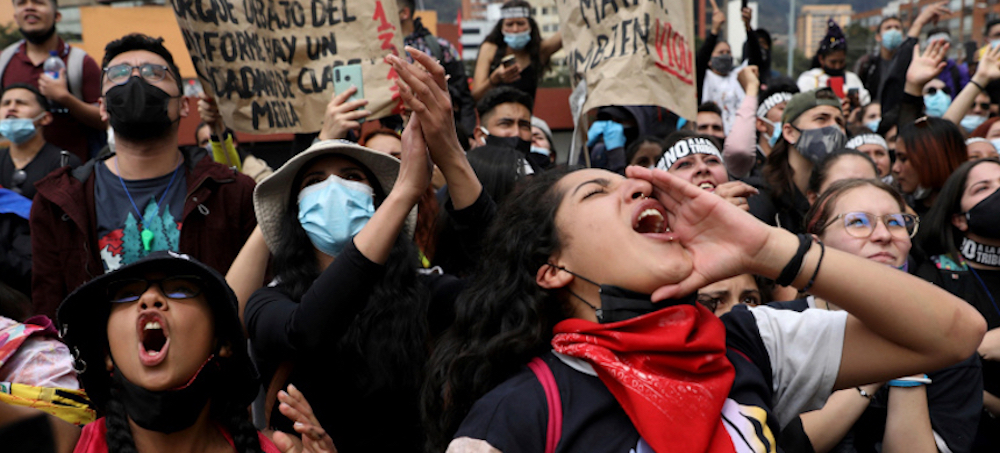 Women shout slogans during a demonstration against the Colombian government's proposed tax reform, in Bogota. (photo: Fernando Vergara/AP)
Women shout slogans during a demonstration against the Colombian government's proposed tax reform, in Bogota. (photo: Fernando Vergara/AP)
Cristhian Hurtado, 27, was one of at least 13 people rights groups and families have said were slain by police in Bogota and its satellite city Soacha amid protests that exploded in September last year after two officers assaulted and killed taxi driver Javier Ordonez.
Since 2019 a series of demonstrations against President Ivan Duque's unpopular government have led to more than 40 civilian deaths, according to government figures. Victims' families, their lawyers and human rights groups say many of the deaths are driven by heavy-handed policing.
Though the army has a long record of rights abuses and unlawful killings during Colombia's six decades of civil conflict, urban police forces were until recently widely thought of as better-trained and more professional.
Despite international outcry, including from the United Nations and European Union, and assurances from Duque those responsible would be brought to justice, only one police officer has so far been detained, under house arrest, for the killings during protests a year ago.
That officer and three others are being investigated over accusations of homicide, the attorney general's office told Reuters - one of them for two separate killings. Reuters was unable to identify the lawyers representing the police officers.
Officers under investigation have been placed on administrative duties, the national director of police, General Jorge Vargas, said in a Thursday Twitter post, adding that he hoped authorities would detain further officers where necessary.
The police had promptly handed over information about munitions used during the protests to the attorney general's office last year, Vargas said, asking forgiveness from those who had been the victim of proven misconduct by police.
Investigations into the death of six other protesters, including Cristhian, are still in an initial stage of inquiries, the attorney general's office said. It did not respond to questions about whether there were investigations over the deaths of two remaining civilian victims identified by advocacy groups.
Like some other families of those killed that night, Carolina and her mother, Maria Elena, insist Cristhian was not even involved in protests. His girlfriend told them he went out to buy breakfast ingredients for the next morning.
"It hasn't been verified who is responsible and it's very probable that person is still in the police and is still wearing the uniform," said Carolina. Her family and their lawyers say Cristhian was killed by a gunshot wound to the head.
A police spokesman said that officers convicted of abuses would be punished to the full extent of the law, but it was for prosecutors to prove their guilt.
The lack of progress in investigations bodes badly for families seeking answers over more numerous deaths at protests that erupted in April this year over unpopular tax reforms, lawyers for the families and rights groups say.
The government says at least 29 people were killed during the two months of protests: those figures include three police officers and several protesters killed by civilians, according to officials. Colombian rights group Temblores has said police are responsible for as many as 44 killings.
To date, 16 officers are being investigated for homicide related to this year's protests, the national police said. Officers under investigation are usually placed on administrative duties.
MILITARY INVESTIGATIONS
Police accused of misconduct face both internal investigation in disciplinary proceedings within the force and, in more serious cases, criminal investigation by the attorney general's office or the military criminal justice unit (JPM).
Police fall under the remit of the Defense Ministry, meaning cases of killings by police which take place in the line of duty - including those at protests - are often handled by the military justice system in the shape of the JPM, rather than the civilian one.
That, human rights advocates and lawyers say, contributes to impunity.
Since 2017, only 23 cases of police killings handled by the JPM have ended in convictions, while 355 have been shelved, the unit told Reuters.
Moreover, it has a lengthy backlog. As of end-June, the JPM had 860 open investigations into homicides committed by officers, it said.
The attorney general's office told Reuters it has opened 172 inquiries connected to killings by officers since 2017, which led to 52 investigations and eight convictions. Only three cases were shelved.
Victims' families, rights advocates and lawyers told Reuters they believed proceedings in the military tribunal were more favorable to officers.
"The military justice system lacks independence and has a long record of covering, rather than investigating, abuses in Colombia," said Jose Miguel Vivanco, Americas director at Human Rights Watch.
JPM executive director Fabio Espitia declined to comment on whether the JPM is more lenient than regular prosecutors. The JPM's press office did not respond to questions.
Internal police investigators, meanwhile, lack independence and authority, said Vivanco.
A spokesman for the national police said disciplinary investigators are well-qualified but the department is congested due to the large number of cases.
He said Vargas has pushed for better human rights standards this year and delicate cases would be handled by the police's top internal investigator.
The police will ask the advice of the U.N. to help strengthen its human rights policies and work toward open communication with communities, the new police director of human rights, Luis Alfonso Novoa, said in a statement on Wednesday after taking up his post.
BAD APPLES
Anger in Colombia over police violence has mounted steadily since Bogota teenager Dilan Cruz was killed by a projectile fired by officers during a protest against rumored pension and minimum wage reforms in November 2019.
In September 2020, a viral video of taxi driver Ordonez writhing on the ground while being repeatedly tasered by police as he screamed for them to stop set off renewed demonstrations. The police said he had violated coronavirus distancing rules.
The heavy death toll in this year's protests – which led to the withdrawal of the unpopular tax and health reforms and the resignation of the finance minister – prompted the government to pledge better human rights training for police and increase oversight of officers.
The president has also blamed police violence on a few bad apples and said cases were being dealt with promptly. He cited the example of officer Juan Lloreda, sentenced to 20 years in prison in April for his part in Ordonez's torture and killing.
The investigation into another officer's involvement in Ordonez's killing continues.
In at least one case of a 2021 protester death, the victim's family is sure bullet and video evidence has helped the investigation advance more quickly.
A police officer was swiftly charged by the attorney general's office in the shooting of 19-year-old Santiago Murillo, who was caught up in a demonstration while walking home from his girlfriend's house in the central city of Ibague. Video of his shooting was widely shared on social media.
"My world fell apart," his mother Milena Meneses said. "He was my only child."
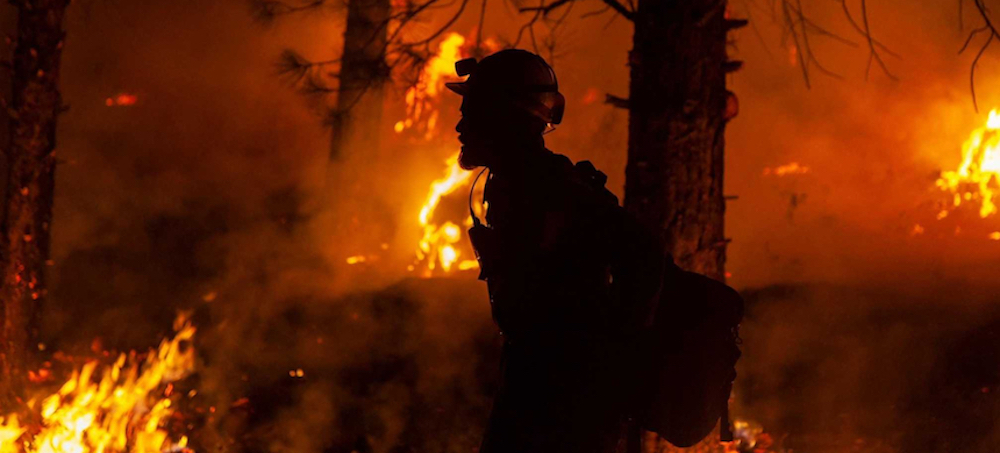 A firefighter during nighttime operations at the Bootleg Fire, near Klamath Falls, Oregon. (photo: U.S. Forest Service/AFP/Getty Images)
A firefighter during nighttime operations at the Bootleg Fire, near Klamath Falls, Oregon. (photo: U.S. Forest Service/AFP/Getty Images)
Our society’s appetite for one kind of burning—fossil fuel combustion—has thrust us into a new Fire Age that is reshaping the Earth.
Now the wildland fires flare up everywhere. There are fires in Algeria and Turkey, Amazonia and Indonesia, and France, Canada and Australia. Last year even Greenland burned.
Fire seasons have lengthened, fires have gotten meaner and bigger; fires have begun not just gorging on logging slash and prowling the mountainous backcountry, but also burning right into and across towns. Three years ago in northern California, the Camp Fire broke out along the Feather River and, burning southwest, incinerated the town of Paradise. Now, the Dixie Fire, starting 20 miles north in the same drainage, is burning in the opposite direction, taking out the historic town of Greenville. The fires have us coming and going.
The causes have been analyzed and reanalyzed, like placer miners washing and rewashing tailings. Likewise, the solutions have been reworked and polished until they have become clichés, ready to spill into the culture wars.
The news media have fire season branded into their almanac of annual events. Scientific disciplines are publishing reports and data sets at an exponential rate. So far as understanding the fire scene, we’ve hit field capacity. What more can we say?
One trend is to go small and find meaning in the personal. But there is also an argument to go big and frame the story at a planetary scale that can shuffle all the survival memoirs, smoke palls that travel across the continent, melting ice packs, lost and disappearing species, and sprawling frontiers of flame, in much the way we organize the swarm of starlight in a night sky into constellations.
I’m a fire guy. I take fire not just as a random happening, but as an emergent property that’s intrinsic to life on Earth.
So I expect fires. All those savanna fires in Africa, the land-clearing fires in Brazil and Sumatra, the boreal blowouts in Siberia and British Columbia, the megafires in the Pacific Northwest — all the flames we see.
But then there are fires that should be present and aren’t — the fires that once renewed and stabilized most of the land all over our planet. These are the fires that humanity, with its species monopoly on combustion, deliberately set to make living landscapes into what the ancients termed “a second nature.”
But it was not enough. We wanted yet more power without the constraints of living landscapes that restricted what and when we could burn. We turned to fossil fuels to burn through day and night, winter and summer, drought and deluge. With our unbounded firepower we remade second nature into “a third nature,” one organized around industrial combustion.
Our fires in living landscapes and those made with fossil fuels have been reshaping the Earth. The result is too much bad fire and too little good, and way too much combustion overall.
Add up all those varieties of burning, and we seem to be creating the fire equivalent of an ice age, with continental shifts in geography, radical changes in climate, rising sea level, a mass extinction, and a planet whose air, water, soil and life are being refashioned at a breakneck pace.
It’s said that every model fails but some are useful. The same holds true for metaphors. What the concept of a planetary Fire Age — a Pyrocene — gives us, is a sense of the scale of our fire-powered impact. It suggests how the parts might interact and who is responsible. It allows us to reimagine the issues and perhaps stand outside our entrenched perspectives.
What we have made — if with unintended consequences — we can unmake, though we should expect more unknown consequences.
We have a lot of fire in our future, and a lot to learn about living with it.
Follow us on facebook and twitter!
PO Box 2043 / Citrus Heights, CA 95611


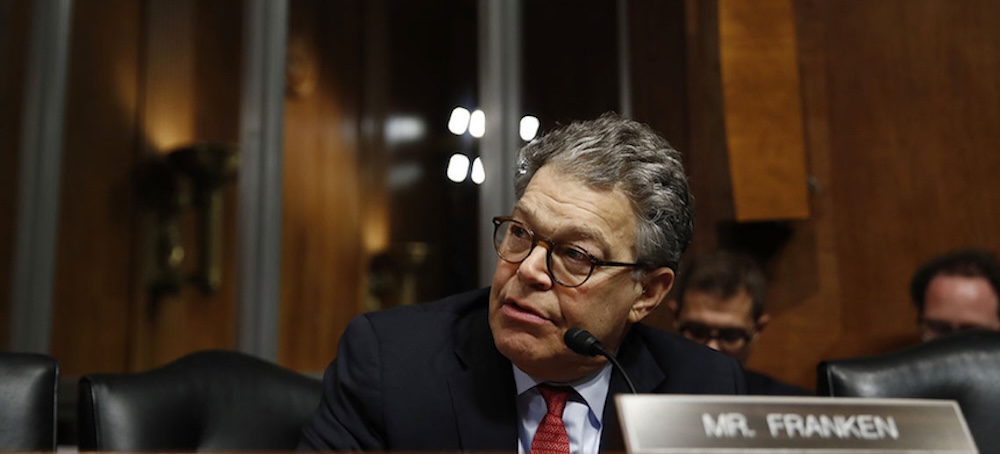

No comments:
Post a Comment